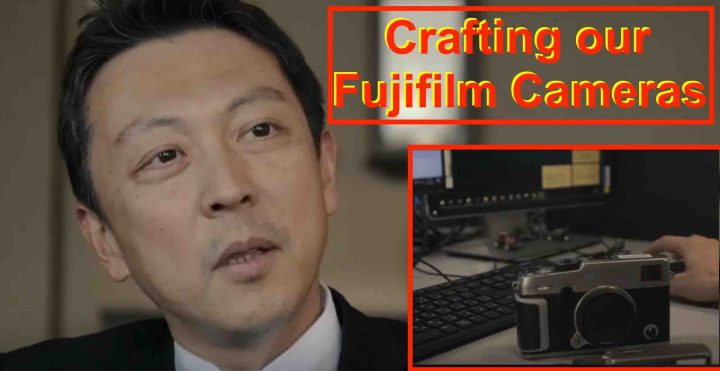Documentary: How Fujifilm Creates Our Cameras – X-Pro3 Not a Product of Logic and About Managers Who Don’t Like Digital Cameras ;)

Fujifilm X Photographer Mindi Tan created a 90 minuted documentary, giving us a behind the scenes to the secret process behind the Fujfilm X-Pro3 creation.
It gives us a very close and also intimate look at Fujifilm’s camera creators and managers. The documentary reveals its team dynamics, beliefs and history inside the company with lots of exclusive interviews and footage.
It also features nine popular X-Photographers from all over the world who open up in their home environments to discuss what being a photographer and being connected with Fujifilm means today.
Down below you can find a summary of the video, but before that, I’d like to leave you with quick impressions I had.
It’s clear to see from the documentary, that behind our beloved Fujifilm cameras, there are not cold managers thinking at specs and profits, but really passionate photographers in the first place.
In fact, top manager’s Toshi Ilda first hobby was photography, and when his father asked him, what he wishes for his successful graduation, he said he’d like a camera.
Also, another top manager, Takeshi Ueno, deeply loves film photography, and straight out says he does not like digital cameras.
I guess this passion for the good old photography reflects perfectly in the vintage design and controls of Fujifilm cameras.
However, it comes even more surprising, that Fujifilm completely denied this “manual” DNA on the Fujifilm GFX100, which is the first Fujifilm camera I ever hold in my hands, that was not intuitive (for me) to operate, and required a look in the manual, to understand how it works.
I am sure there will be many, who love the more “modern” layout of the Fujifilm GFX100, and that’s perfect. I can understand. But it’s just not my style, not my preference.
I think Fujifilm should continue to offer what makes them unique, and part of that is not to give up vintage controls. And with the X-Pro3, they pushed this concept to its limits, by even hiding the LCD.
Also interesting:
They say the X-Pro3 is not a product of “logic”, but of instinct. In this case they did not listen to what the market dictates, but their intuition, that it was the right thing to do with the X-Pro3.
And that’s why I love Fujifilm.
If they would be like Sony for example, and just listen to market logic, Fujifilm would just offer one camera body. The same for everybody.
But Fujifilm knows photographers are not all the same, and so they offer niche products, that will never really become that profitable. By doing so, Fujifilm honors its photographic culture and heritage, it’s photo-DNA.
It’s a very lovely documentary, that I invite everybody to watch.
Video and Summary
- Takeshi Ueno, digital camera creator manager, starts by saying he does not like digital cameras
- Toshi Ilda said he probably married with Fujifilm. He let’s freedom to his stuff. All he needs is a common goal. On how to do that, he trusts his co-workers
- as of 13 March, 2019, Fujifilm offered: 20 cameras, 39 lenses, 250 firmware updates
- the X-Pro3 was developed and produced within 1 year
- sometimes they need to find right balance between costs, design and features. It’s not a compromise, but a consensus
- people won’t need point and shoot in future
- Fuji needs to enter high end camera market
- “X” usually includes “eXperimental”, meaning making cameras that others don’t have
- product planing manager is like a conductor of an orchestra. He has an idea, and he conducts the team
- The Fujifilm manager team in Japan has weekly meetings
- they always talk to photographers
- Fuji manager Jun started the X-T series. He thought having rangefinder only cameras is not enough
- goal of X-Pro3 is to be discreet
- X-Pro3 designed for “blind” control. A camera that can be used without looking at the manual
- X-Pro1 autofocus had lots of potential, but far away from perfection. Autofocus also slow
- The creator of the X-Pro2 says he created with all the knowledge he had about cameras and photography
- He loves analogue cameras much more, and tried to put that analogue feel into the X-Pro
- X-Pro3 aimed at street photographers
- Fujifilm invited some X photographers to Japan to brainstorm for 2 days about the Fujifilm X-Pro3
- X Photographer David Bouvet says “if you love your camera and lens, you will take better pictures”
- hidden LCD leads users to the viewfinder
- playback action disturbs the action of shooting
- X-Pro3 is a product of hobby, not logic. So despite knowing hidden LCD would not be popular, they made it
- designed by inspiration, not by logic
- digital camera age has forgotten the passion for photography
- they explain how the Fujifilm X photography came to be
- Fujifilm takes a lot of feedback from photographers
- hardware improvements are more important than firmware improvements, when it comes to developing a new product
- improvements never stop, also continues via firmware
- Toshi Ilda first passion was photography. It was the first thing he wished his daddy to buy him after he graduated
- sometimes Fujifilm must listen to customers, sometimes they just have to make decisions. In X-Pro3 case they just took this decision
- If you’re new to photography you’ll learn from the camera, but if you are old to photography you will love this camera
Fujifilm X-Pro3: BHphoto, AmazonUS, Adorama, FocusCamera
- Support FujiRumors on Patreon
- Follow FujiRumors on Facebook, Flipboard, RSS-feed, Twitter, Youtube and Instagram
- Join our User Groups: Fujifilm X-T, GFX, X-H, X-Pro, X-E and X100 line
- Best Facebook Pages: Fujifilm X-T, Fujifilm X-H and Fujifilm GFX

